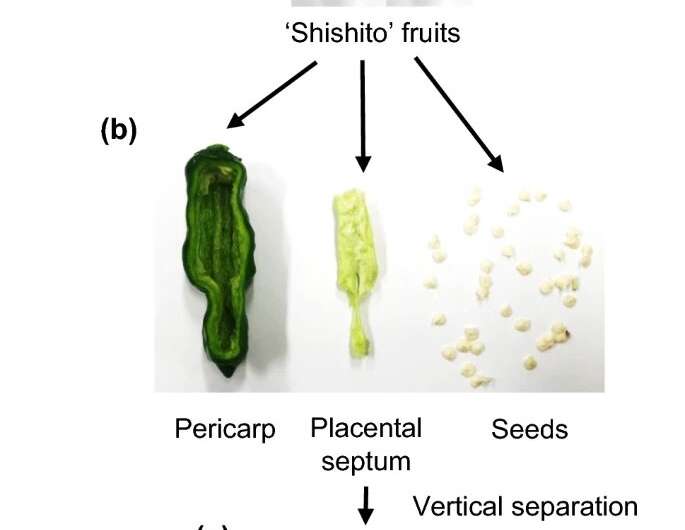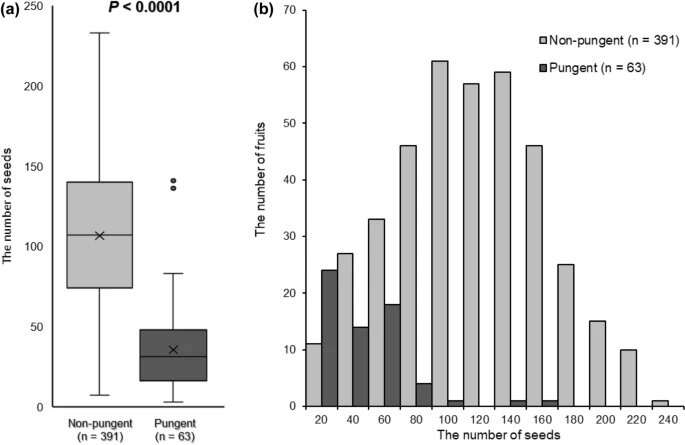Pungency variable of Shishito sweet chili pepper: Genes and seeds

Chili peppers (Capsicum spp.) are an important spice and vegetable that supports food culture around the world, whose intensity of its pungent taste is determined by the content of capsicumoids. However, the content of capsicumoids varies depending on the variety and is known to fluctuate greatly depending on the cultivation environment. This can be a big problem in the production, processing and distribution of peppers where sweet varieties can be spicy and highly spicy varieties are just only mildly spicy. It is thought that changes in the expression of multiple genes involved in capsaicinoid biosynthesis are involved in such changes in pungent taste depending on the cultivation environment, but the mechanism is not clear.
In Japan, the main variety of pepper is the vegetable pepper shishito, which has almost no spiciness. However, sometimes spicy fruits are produced, which makes eating shishito like playing Russian roulette. People have known from experience that "fruits with a fewer number of seeds are spicy." Researchers set out to determine the number of seeds inside the shishito pepper and the intensity of pungency of the fruit, and the gene expression control mechanism that causes the fluctuation of the pungency of the shishito fruit.
Corresponding author, Associate Professor Kenichi Matsushima of the Institute of Agriculture, Shinshu University states that the pungency of chili peppers with fewer seeds is more likely to fluctuate in pungency and that these pungency fluctuations are caused by the expression of multiple genes involved in capsaicinoid synthesis.
The research group investigated the pungent intensity of shishito fruits with a variety of number of seeds, with a tasting test and measurement of the capsaicinoid content. The placentation/partition (taiza/kakuheki) tissue in the fruit where capsaicinoids are synthesized was vertically divided into two equal parts, one was measured for pungent intensity and the other for the expression of genes involved in capsaicinoid synthesis. As a result, the spiciness of the shishito fruit with a large number of seeds was very weak, whereas the spiciness of the fruits with a small number of seeds ranged from weak to strong.

The group investigated the relationship between the intensity of pungency and the degree of gene function within the same fruit. As a result, among the genes involved in capsaicinoid synthesis, the expression levels of 10 genes showed a positive correlation with the pungent intensity, and it was found that the higher the expression level of these genes, the stronger the pungent taste. Therefore, it was clarified that in shishito peppers, the activation of these 10 genes increases the amount of capsaicinoids synthesized and enhances the pungent taste.
There have been many studies investigating how much the pungent intensity (capsaicinoid content) of peppers changes depending on the cultivation conditions, but few studies have investigated gene expression. In this study, the pungent fluctuation phenomenon of chili pepper was investigated at the gene expression level. The group clarified the relationship between the two by using a unique experimental method of simultaneously investigating pungent intensity and gene expression by using the placenta and septum of shishito in two equal parts.
In addition to the results of this research, this novel method can also considered to be important outcome for investigating the pungent fluctuation phenomenon in the future. Associate Professor Matsushima hopes to utilize the knowledge and information on the expression level of genes that have been found to be significantly involved in pungent fluctuations for future pungency breeding of chili peppers. It was revealed in this study that the pungent intensity of pepper and the expression level of multiple genes involved in capsaicinoid synthesis are closely related.
![Capsaicinoid biosynthesis pathways and the involvement of the 18 analyzed genes in the present study. Letters in each circle indicate the gene name and the ten co-expressed genes whose expression levels had positive correlations (P < 0.01) with capsaicinoid concentration in 'Shishito' fruits are represented by white letters in black ovals. Gray dotted lines linking between each gene indicate that strong positive correlation (r > 0.8, P < 0.001) was observed in expression levels between the two genes. PAL phenylalanine ammonia lyase, C4H cinnamate 4-hydroxylase, 4CL 4-coumaroyl-aoenzyme A ligase, HCT hydroxycinnamoyl transferase, C3H coumaroyl shikimate/quinate 3-hydroxylase, COMT caffeic acid O-methyltransferase, pAMT putative aminotransferase, BCAT branched-chain amino acid transferase, BCKDH branched-chain α-ketoacid dehydrogenase, ACL acyl carrier protein, KAS ketoacyl-ACP synthase, CaKR1 ketoacyl- ACP reductase, FAT acyl-ACP thioesterase, ACS acyl-CoA synthetase, AT3 acyltransferase 3. [modified from Arce-Rodr.guez and Ochoa-Alejo 2019; Koeda et al. 2019] Credit: Copyright © 2021, Fumiya Kondo, Kenichi Matsushima et al., Shinshu University, under exclusive licence to Springer Nature Switzerland AG, part of Springer Nature Pungent-variable of sweet chili pepper Shishito: genes and seeds](https://scx1.b-cdn.net/csz/news/800a/2021/2-pungentvaria.jpg)
Based on this result, if the expression level of these genes can be suppressed, it may be possible to grow vegetable varieties that are less likely to fluctuate in pungency. They are aiming for a variety of shishito that does not produce irregularly of spicy fruits, while retaining the unique flavor, which is different from the peppers that are not spicy at all. Therefore, the results of this research will be applied to pepper breeding, and the ultimate goal is to establish breeding technology for these genes and their functions.
More information: Fumiya Kondo et al, The pungent-variable sweet chili pepper 'Shishito' (Capsicum annuum) provides insights regarding the relationship between pungency, the number of seeds, and gene expression involving capsaicinoid biosynthesis, Molecular Genetics and Genomics (2021). DOI: 10.1007/s00438-021-01763-4
Provided by Shinshu University




















